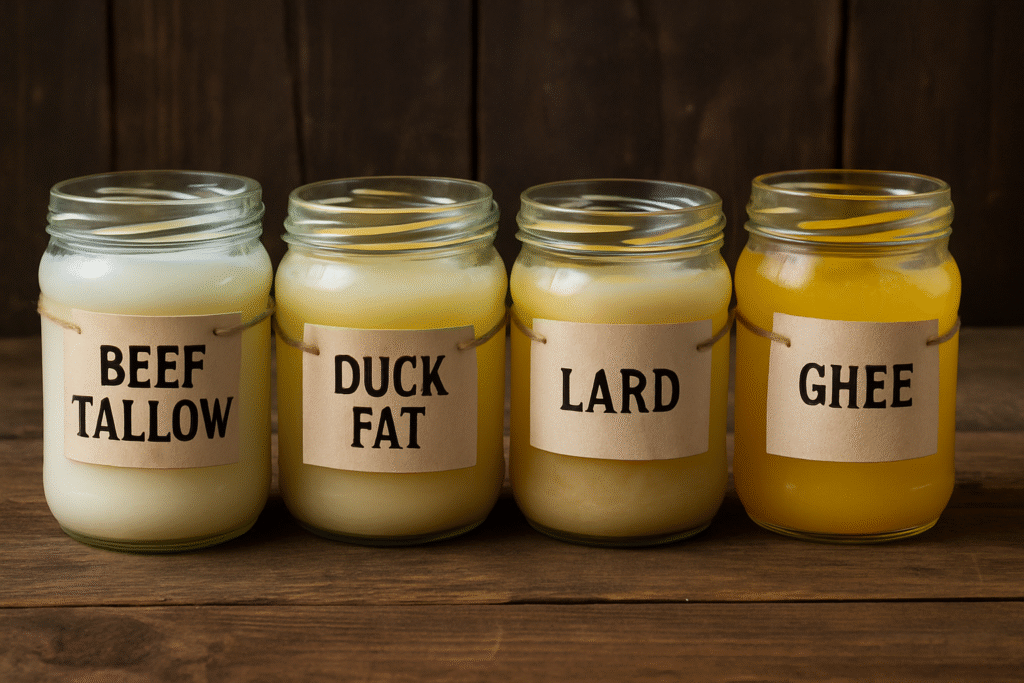We’ve been told to cook with “heart-healthy” oils like canola and vegetable oil. You know the ones—they come in giant plastic bottles and claim to be “light” or “cholesterol-free.”
But here’s the deal: those are the worst fats you could be cooking with.
When it comes to high-heat cooking—think searing steaks, frying eggs, or crisping up a cast iron pan—not all fats are created equal. And if you want flavor, performance, and real health benefits, the answer lies in animal fats, not the industrial stuff.
Let’s dive into the top high-heat cooking fats from a Paleo, nutrient-dense, and ancestral perspective.

1. Beef Tallow: The OG of High-Heat Cooking
Smoke point: ~400°F
Taste: Clean, mild, beefy richness
Best for: Roasting, frying, sautéing, pan-searing
Beef tallow is rendered fat from cattle—and it’s one of the most stable, nutrient-rich fats you can use. Our ancestors used it for centuries before it got replaced by Crisco and canola.
Why it’s great:
- Rich in saturated fats (which are heat-stable)
- Naturally contains fat-soluble vitamins like A, D, and K2
- Gives foods an incredible golden crisp without breaking down
Use it to fry potatoes, sauté meat, or even roast veggies (if you still eat them).
2. Duck Fat: Gourmet Meets Ancestral
Smoke point: ~375–400°F
Taste: Savory, luxurious, subtly gamey
Best for: Roasted potatoes, pan-seared meats, sauces
Duck fat is having a moment in gourmet kitchens, but it’s been a staple in traditional cuisines for centuries. It’s slightly more unsaturated than tallow but still incredibly stable at high temps.
Why people love it:
- Rich, deep flavor that elevates basic dishes
- Great for crisping skins, caramelizing onions, and finishing sauces
- Perfect balance of monounsaturated and saturated fat
This is the one to break out when you want to impress guests—or just treat yourself.
3. Lard (Pork Fat): Misunderstood and Underrated
Smoke point: ~370°F
Taste: Mild, slightly savory
Best for: Baking, frying, sautéing, biscuits, tortillas
Lard got a bad rap thanks to flawed science and processed shortening. But real, pastured pork lard is a clean, flavorful fat that holds up beautifully in the kitchen.
Why it’s back in style:
- Higher in monounsaturated fat than you’d expect
- Stable for most cooking methods
- Makes flaky, perfect Paleo baked goods
Make sure it’s leaf lard (from around the kidneys) for the cleanest taste.
4. Ghee (Clarified Butter): Buttery Without the Burn
Smoke point: ~450°F
Taste: Buttery, nutty, clean
Best for: Searing, sautéing, Indian dishes, finishing
Ghee is butter with the milk solids removed—making it ideal for anyone sensitive to lactose or casein. It has a higher smoke point than regular butter, and it’s loaded with butyrate, a short-chain fatty acid that supports gut health.
Bonus: it’s shelf-stable and adds a rich golden hue to any dish.
5. Coconut Oil (Honorable Mention)
Smoke point: ~350°F (refined), ~400°F (virgin)
Taste: Slight coconut sweetness (less with refined)
Best for: Baking, quick stir-frying, medium-heat dishes
Coconut oil is more plant-based, but it’s an exception. It’s high in saturated fat (over 90%), which means it’s super stable for cooking. Just be mindful of the flavor—it can come through in lighter dishes.
What NOT to Use for High Heat
Let’s get this out of the way:
Do not cook with:
- Canola oil
- Soybean oil
- Corn oil
- Grapeseed oil
- Sunflower/safflower (especially high-linoleic versions)
Why? These oils are packed with unstable polyunsaturated fats (PUFAs) that oxidize under heat, producing toxic byproducts and inflammation. They also hang out in your body for months.
If it came from a seed and needed a lab to extract, skip it.
Leave a Reply